In stitching talk, silk gauze is not exactly what it sounds like – it isn’t gauzy, light silk that might be used to make a filmy, floating scarf. In the stitchery world, “silk gauze” is a kind of canvas – a miniature canvas, in fact, onto which you can embroider (usually in counted techniques) little things. Silk gauze is made out of filament silk, which makes a very strong, very fine canvas, and while it comes in lower holes per inch (as low as 18), it is probably better known in its higher holes-per-inch counts, as it is prized by those who love to do miniature work.
Silk gauze is similar to a needlepoint canvas, in that it is measured in “holes per inch” rather than “threads per inch” (which is how most counted embroidery fabric is measured).
Silk gauze can be found in Very High thread counts – as high as 112 holes per inch. (No matter how good your eyes may be, I suspect you’d have to use magnification at 112 HPI!) The more commonly used sizes of silk gauze range from 40 HPI (holes per inch) up to 72. 40 & 48 HPI silk gauze is fairly easy to come by. 60, 72, and higher require some serious hunting for specialty suppliers.
On silk gauze, especially higher count silk gauze, the recommend stitch to use is the tent stitch.
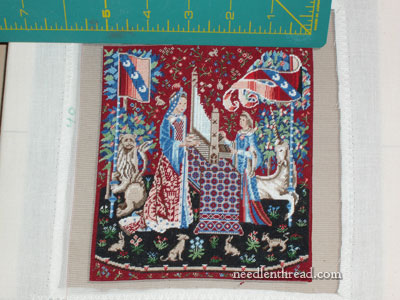
Now, why am I talking about silk gauze all of a sudden? Well, it’s not as if I haven’t talked about it on Needle ‘n Thread before. You might remember that last year, I worked this miniature embroidery project, practically in 15 minute-or-so increments, until it was finished. It was a great little project to work in short increments!
But… that’s not what we’re talking about here.
I’ve started a different silk gauze project. This one defies standard notions of embroidery on silk gauze. I’m trying silk gauze as a ground fabric for something that it’s not normally used for – and I’ll tell you what, later.
For now, I’ll just show you how I set up a piece of silk gauze for stitching, especially if: a. the project is going to take a little bit of time; b. the project is somewhat larger than normal; or c. I need very good tension for the type of stitchery I’m planning to do. In this particular case, the reason for setting up this particular piece of silk gauze the way I’m setting it up is c – because I need firm, consistent tension on the gauze.
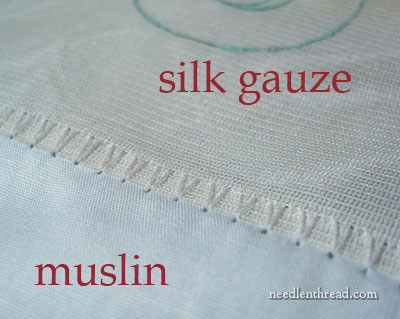
First, you need your piece of silk gauze. I’m just using a smallish scrap piece, to test my theory. It’s about 2.5″ high and about 3.5″ wide. Second, you need a piece of good, high thread count muslin cut to fit the size of the stretcher bar frames (or hoop) that you’re going to use.
With the smaller piece of silk gauze centered on the muslin, machine stitch around the edge of the silk gauze. You can also overstitch the edge of the silk gauze by hand, but it’s much easier to do it on a machine if you can. Use a zig-zag stitch or overlock stitch, if you have an overlock foot. If you have a serger, you can use it.
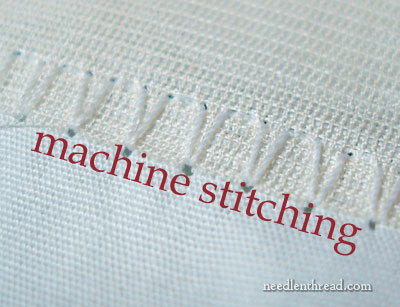
You can see the machine stitching here, over the edge of the silk gauze and into the muslin.
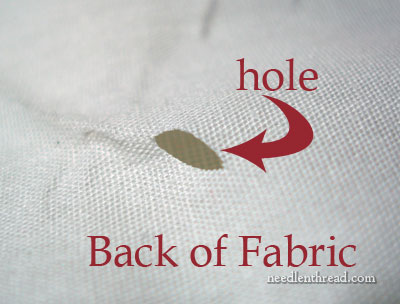
After you’ve sewn the silk gauze to the muslin, turn the muslin over, and in the area behind the gauze, snip a tiny little hole in the muslin. If you pinch the muslin so that it is separate from the silk gauze, you can do this easily without snipping the gauze.
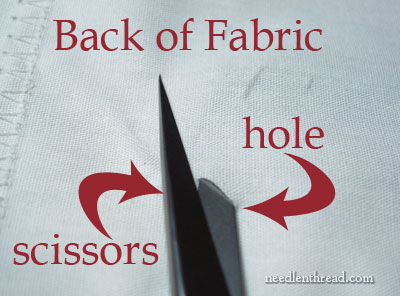
Using a fine small pair of embroidery scissors, slip the scissors carefully into the hole, keeping the blades in contact with the muslin and avoiding coming into contact with the silk gauze. Carefully cut away the muslin behind the silk gauze, up to your machine stitching.
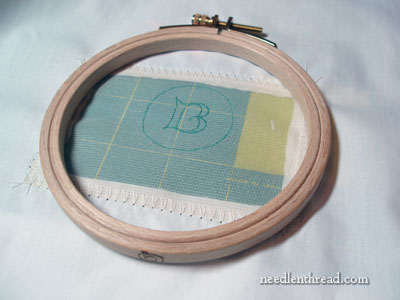
Now you have a little open window in your fabric, behind the silk gauze, and you have a piece of fabric that can easily be held taut, either by a hoop…
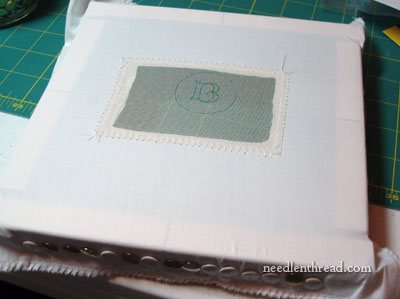
… or, in this case, for this project, by a stretcher bar frame.
Now, you’re ready to start stitching! Errr…. after getting out that magnifying lamp that you know you need!
I’ll show you what I’ve done with this little thing later on. You can see there’s a small monogram on it, but you’ll have to wait to see what I do with that monogram. I’ve only just begun to play around with it.
And if my trial-and-error stitching is a dismal failure, never fear! I’ll still show it to you! That way, we can all live and learn, eh?
Tomorrow, I’m doing a book give-away, so do drop by! See you then!







OKay, Mary — I’m intrigued!!
OOH, what a fun teaser! I can’t wait to see it!
Hi Mary,
Wondering what your up to now. Can’t help myself of thinking of Anne Boleyn neckless when looking at that B Monogram. lol
I for one are very curious now!!! I recently finished a Christmas Camel in tent stitch on 75 count which you can see here
http://elgakoster.blogspot.com/2012/01/christmas-camel-finished.html
I have also used cross stitch on 60 count which I much prefer to tent stitch
http://elgakoster.blogspot.com/2011/05/guild-school-auction.html
Fantastic, Elga!! Oh – that camel is Terrific! ~MC
The word silk and cutting a hole is a scary combination!
Deb
Hi Marymentor 🙂
This is such a really NEAT technique for setting up a small piece of background fabric to work on. Guessing “any” small fabric would lend itself to this ingenious idea. Thanks so much. You’re always there with answers to my questions before I ask them……Hope you are faring better in the plains states than we are in Pittsburgh…”snow-wise..that is ” 😀 Judy in Pittsburgh
Mary …. even with the magnifier, you must have near miraculous eyesight!! hahaha. Take care of those eyes!
Dear Mary,
Could it be you might be doing a little bead work with the silk gauze? I know you said your project for this silk was to have embroidery but I can hope to see some bead work.
Maria in Kansas
Speaking of magnifiers… I am new to embroidery and wonder if anyone can recommend a good magnifier, preferable that doesn’t have to sit on a table as I usually do my needlework in my recliner. Also, any ideas for a decent cutting table that doesn’t cost and arm and a leg?
Thanks!
Hi Mary,
do you think that will give a good result making a slip for a stumpwork project using silk gauze instead of linen ? Has this firm edges when cutted ?
Thanks !
Hi, Francesca! Well – yes – I think it would! 🙂
Catrina … my two go-to places are Nordic Needle and The Stitchery. Both are online and have a large selection of EVERYTHING! But take care because you’ll want to spend far beyond your budget! 🙂
this is a clever tip, thank you !
Mary,
What would lead one to choose silk gauze rather than linen for a project?
Teeeeeny Tiiiiiiny! That’s what!! 🙂 I’m mixing techniques a bit. Silk gauze, by the way, works great for making tiny detailed “slips” for stumpwork and so forth….
I’m so curious to see what your up to now!
Amazing that you find the time to keep up with your daily posts and that to , such interesting ones when you have a big project like the medallion going on! Thank you, I look forward to your post everyday.
Can’t wait to see what you’re doing with this!
Don’t make us wait too long,I want to see what you’re doing!
Yesterday I got out the little piece of silk gauze that I have been looking at for a year or so, and now I know how to mount it. Your timing is perfect. Since I just found a design that I think will be the right size, 2012 will be the year I stitch on silk gauze…Maybe I’ll wait to see what you’re doing, in case you have lots of good advice.
I know this is an old post but just had to tell you that finding this has solved many problems I have. I use odd kinds of material to needlepoint on, odd fabric and even nylon screen from the hardware store. Getting odd things on a stretcher bar has been a problem. Doing this technique will also give me a way to use a hoop on small projects. Now I have a solution! Thank you, thank you!
I am looking for 24 count silk gauze for petit point embroidery.
I am loving your website!! Tell me, PLEASE, where I can purchase silk gauze for petitpoint. I’ve found a couple of sources online, but the pieces I was interested in buying were no longer available.
Do you sell this….and if so, could you tell me what is available, and how much they are?
Many thanks for your help!
You can find it online through Needle in a Haystack – just search their catalog for silk gauze.
Hello – I’d like a little help with using silk gauze. Some years back at a stitching show I saw one of the Lavender and Lace patterns done on silk gauze instead of the ubiquitous Aida/Belfast cloth. I was in a hurry and didn’t have time to stop and query the woman who did it to get more info. Do you know of anyone, or have you, done any of those cross stitch patterns using silk gauze. I remember being struck by how delicate it looked – it gave it a whole new dimension. But I am recalling from many years back, so perhaps my memory has elevated what I saw to a height that in fact, is no big deal. I don’t know. Which is why I have contacted you so that perhaps you could give me some insight in this gauze option. Even more years ago, I worked a large number of petit point designs, mostly using 2 thread, however, I have done my share of one thread work – far too small for my eyes now. Thanks in advance for any help you can provide. I live in Vancouver and believe it or not, there isn’t a needlework store that I can go to for advice, information, or inspiration.
Again, many thanks.
Colleen
Hi, Colleen –
Most silk gauze is one-thread work in very small petit point. You’d just follow the pattern like you do for cross stitch but you’d work petit point instead. Silk gauze commonly comes in 40 and 48 threads per inch, and you stitch over one with one strand.
Thank for you the guide! I’ve never stitched on silk gauze before, so I was worried about how to hoop it. Now I can do my next project with confidence (I hope lol)